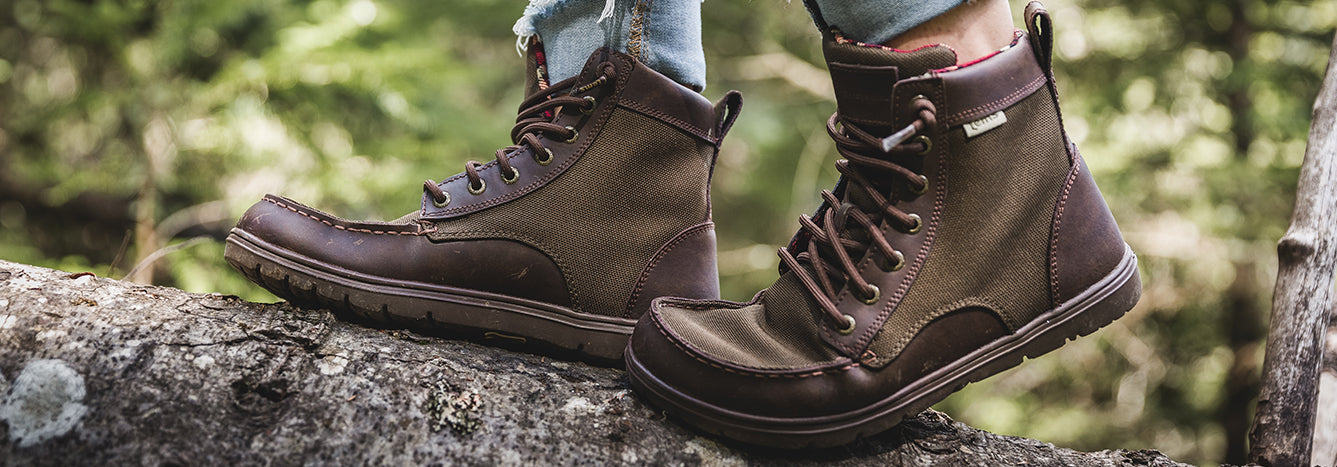One of the most essential things to understand in natural footwear design is a term known as drop. In fact, we could argue that zero-drop is the whole point of wearing minimalist shoes.
At its most basic, shoe drop is the differential in height from the heel to the forefoot. It ranges from a drop of zero, like most Lems shoes and boots, to upwards of 12 millimeters in traditional running shoes, to astounding heel-to-toe variances in high heels such as stilettos.
DIFFERENCE BETWEEN DROP & STACK HEIGHT
Many people confuse drop with other shoe design elements like stack height. The latter is a measure of cushioning height inside a shoe. Adding to the confusion, zero-drop shoes can be made with no, low or high cushion. In fact, some super-cushy “maximal” running shoes actually have very little or no drop above the stack height.
Lems, for example, prefers next to nothing in the cushion department, because a combination of zero-drop and minimal stack height places the foot as close to the earth as possible, where it was designed to stride.
“I have tested barefoot, minimal, and maximal running, and many, many different shoes. I have dissected shoes and thought about how the big companies went wrong,” says Lems founder and designer Andrew Rademacher.
“I continue to learn every day. The truth is that there is no perfect shoe for everyone, and for that matter, anyone. But today we can get much closer to the optimal shoe for each person and each activity that we decide to do.”

DROP IMPACTS THE WHOLE BODY
Drop is how far the rear of foot is elevated above the front. It is most dramatic in high-heeled shoes and many of the tall and narrow footwear fashions that have dominated American and European cultures for centuries.
We continue to want to make ourselves look taller through our shoes. But that’s leading to all kinds of health issues. If you imagine that wearing high heels is like standing on your tiptoes all day, it’s pretty clear that this is not natural.
Not only is this angle damaging your feet, but it also affecting your entire body alignment. Many of our aches and pains are tied to spine alignment or posture, and wearing high-drop shoes is throwing us way out of whack.
There is vast research to support that the more drop a shoe has, the more it pushes the body into a forward-leaning position. This puts extra stress on certain joints, especially the ankles, ball of the foot and calf muscles.
Getting our bodies back to the way they first moved—barefoot—is the only long-term fix for many of the health concerns we face. We can spend tons of money on different shoes touted to “correct” alignment or custom orthotics, but those are essentially big Band-Aids for our feet.
The most natural way we can walk while still having our feet protected is in zero-drop shoes, where the heel and forefoot are level and balanced for our spine.
“Our ankles are designed to be in this zero-drop position, so when you add any heel to a shoe it puts the ankle at a higher angle and immediately the ankle joint is out of alignment,” says Rademacher.
But the damage doesn’t stop at the ankles.
IMBALANCE RADIATES THROUGHOUT SPINE
Shoes with even the slightest measure of drop start to throw a variety of joints out of alignment. Remember, these joints were first meant to move the body while barefoot, flat on the earth.
Walking might sound simple. But the human gait involves half of the body’s 650 muscles and 200 bones, along with a large share of the joints and ligaments, according to Dr. William A. Rossi, who explores this issue in-depth in his article “Why Shoes Make ‘Normal’ Gait Impossible.”

In a shoe with drop the toes are more pointed, and there’s more tension on the front part of knee and less on back,” Rademacher explains. “This changes muscles and tendons and also causes you to stick your butt out and arch your back. It also leads to IT band issues and ultimately works its way up the whole spine.”
The same holds true for low back pain. It could very likely be related to your body’s core platform—your feet—and what shoes you are putting them in.
THE ANGLE OF DECLINE
It’s hard to imagine that a few millimeters difference between the rear and front of your foot could make that much difference. But it does.
Maybe an analogy will help. When a shoe puts your heel into a lifted position, your foot is now perched at around a 20-percent grade. That’s the descending angle from your heel to your foot. Now compare walking at that decline to driving a car down a steep hill.
Experts suggest that anything more than an 8 percent downhill grade becomes dangerous, because there’s that much more weight on the front part of the vehicle. It’s loaded and unbalanced. You’ve got to hold the brakes hard.
In a high-heeled shoe you are standing and moving at more than double that grade. Now imagine hiking down steep terrain in that same shoe. If the terrain itself is a 20-percent grade and your shoe is a 20-percent grade, you are in effect doubling the force with which you land on the front of the foot, while also forcing the toes and forefoot unnaturally into the toe box of the shoe. Ouch.
There’s no doubt that shoe drop is doing damage. But it’s never too late to correct that. Stay tuned for more information about how to transition from your normal shoes to a zero-drop shoe.

